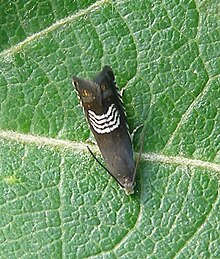Grapholita compositella
| Grapholita compositella | |
|---|---|

| |
| Scientific classification | |
| Domain: | Eukaryota |
| Kingdom: | Animalia |
| Phylum: | Arthropoda |
| Class: | Insecta |
| Order: | Lepidoptera |
| Family: | Tortricidae |
| Genus: | Grapholita |
| Species: | G. compositella
|
| Binomial name | |
| Grapholita compositella (Fabricius, 1775)
| |
| Synonyms | |
| |
Grapholita compositella, the clover seed moth, is a moth of the family Tortricidae. It is found from Europe to Asia Minor, Mongolia, China and eastern Russia. It is also present in North America.
The wingspan is 8–10 mm. There are two generations per year, with adults on wing in May and June and again in August. Males fly during the day, while females fly towards sunset.
The larvae feed on Trifolium species, including Trifolium pratense and Trifolium repens. They have also been recorded on Glycine max, Medicago sativa, Melilotus, Lotus corniculatus and other Leguminosae species. The larvae of the first generation feed in the stems, tunnelling upwards from the base. Second generation larvae usually feed in spun terminal leaves and flowerheads, and sometimes in the pods. Pupation takes place in a whitish silken cocoon amongst litter on the ground.
External links
